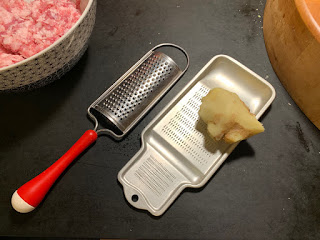I bought a large piece of pork belly with skin and all; the skin is a necessary ingredient for making xiao long bao 小籠包. Of course you can take shortcut and buy a package of gelatin.
this piece weighed in at 3 pounds
I saved some for making a braised pork belly dish; you want them in these big cubes
for the rest I trimmed off the skin to render the gelatin for used in making xiao long bao 小籠包
for best mouth feel I avoided using a meat grinder to grind the pork; ideally there should be a lot more pork fat
this is my special purpose cutting board for mincing meat; I use this deadly looking Thai kitchen knife
it is best to do this on the floor to minimize the commotion; my neighbors must wonder what were that
I tried to decide which is a better grater to grate a lot of ginger
next is to season the minced pork
The seasonings are relative simple:
- grated ginger (a lot)
- salt
- white pepper
- Chinese cooking wine
- soy sauce
- sesame oil
I made two batches, one for xiao long bao 小籠包 and one for potstickers 鍋貼
As the xiao long bao 小籠包 requires more preparation including the gelatin I want to make some potstickers 鍋貼 first. Also potstickers 鍋貼 requires less skills so that would be a good one to ramp up.
I wanted to have some green vegetable in the potsticker. I bought some chrysanthemum. Chrysanthemum is an interesting vegetable. Most people who try it first time either like it or hate it.
the chrysanthemum is blanched and the excess water is squeezed out and then diced
one problem in making these dishes is you ending up enough to feed a family
not knowing how it will turn out I made one to test first
not the best looking potsticker in the world
the filling can use a little more salt
they are very juicy and the juicy runs everywhere as soon as you take the first bite
this photo was taken in Din Tai Fung 鼎泰豐 we went to in Toronto
Portland now has a Din Tai Fung 鼎泰豐 but I no longer have the urge to go
The xiao long bao 小籠包 will be made the next day, as the filling needs to include some diced jelly like gelatin.
the skin being rendered to extract the gelatin
Here is a second batch that I made for dinner. I wanted more vegetable so I added more and adjust the seasoning to get it just right. I added just a bit of sugar also. As now I armed with the experience of the first few that I made I made a batch of six and pan fried them all at the same time.
more chrysanthemum
I also learnt that you want to squeeze the seams really well to prevent leaking when biting into the potsticker
you start with a bit of oil in a medium hot pan and lay down the potstickers; a cast iron skillet is one of the best pan to use and no sticking if you do it right
once the bottoms is slightly heated you pour in water and place the lid on; the steam is needed to cook the tops
this batch is more photogenic - all the bottoms are evenly browned
the filling is rich with umami and juicy, and with adequate chrysanthemum
Lastly for proper nomenclature. These are rightly called potsticker 鍋貼 (guotie) instead of gyoza 餃子. 鍋貼 literally means sticking to the pan. China has countless types of gyoza 餃子. They are generally smaller (more of a bite size) and are cooked in water or broth. And please don't call this dumping, as it is so so wrong. Again China have countless types of dumplings. Dumpling typically are round as a ball, and can be savory or sweet.



































No comments:
Post a Comment